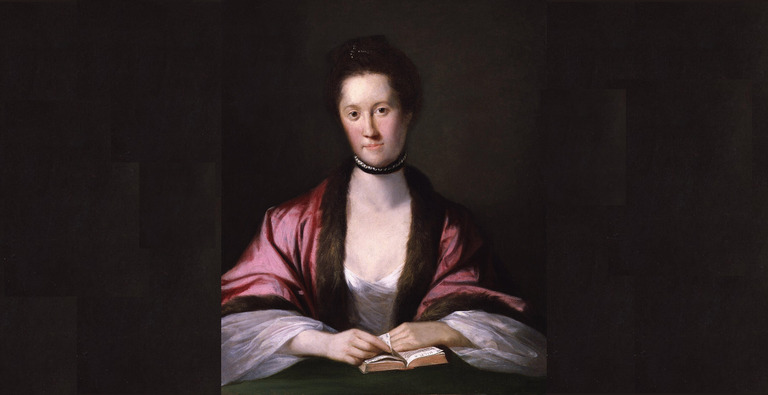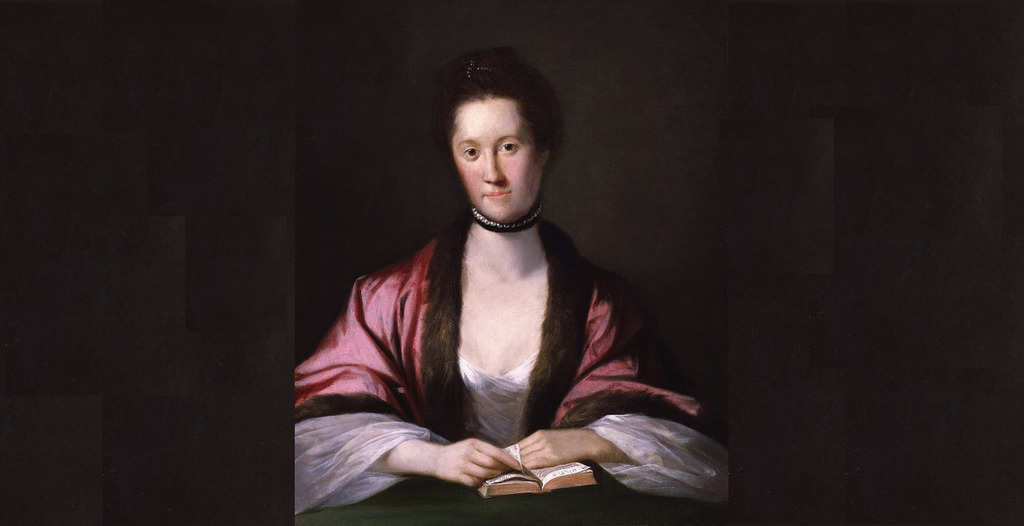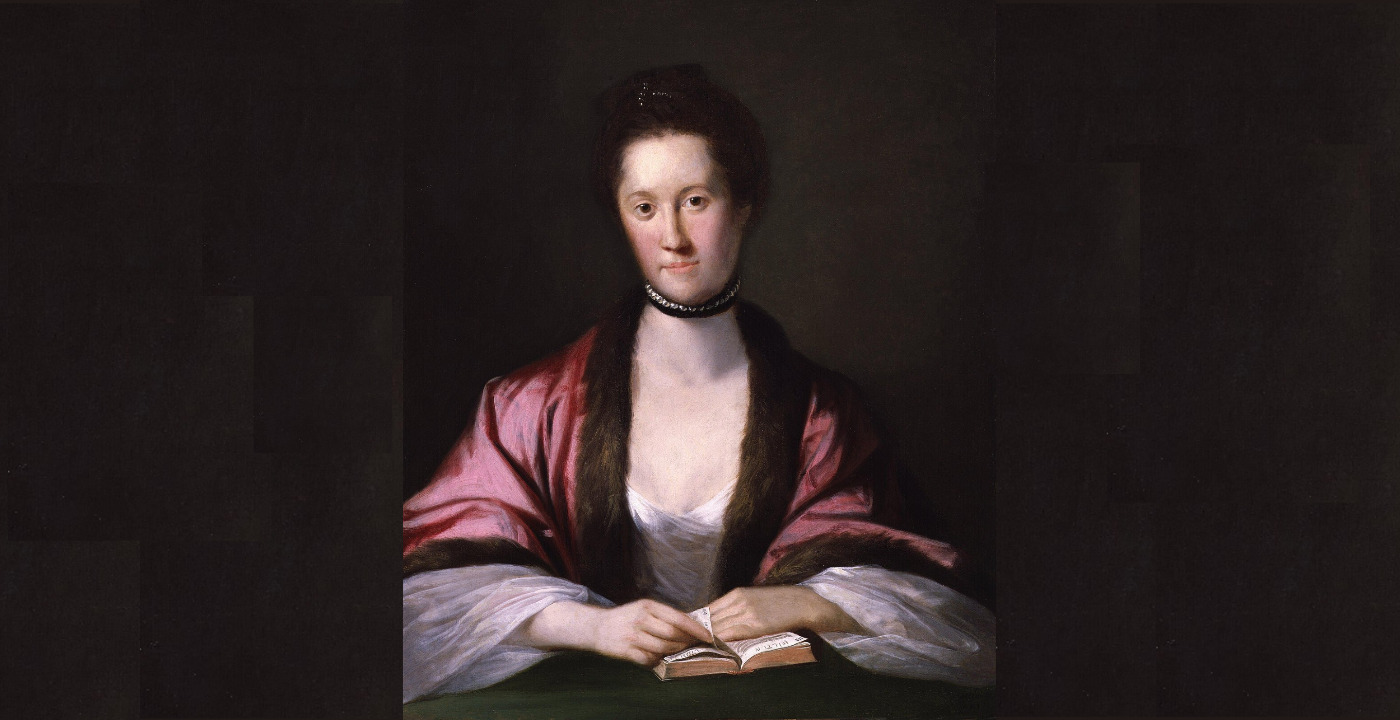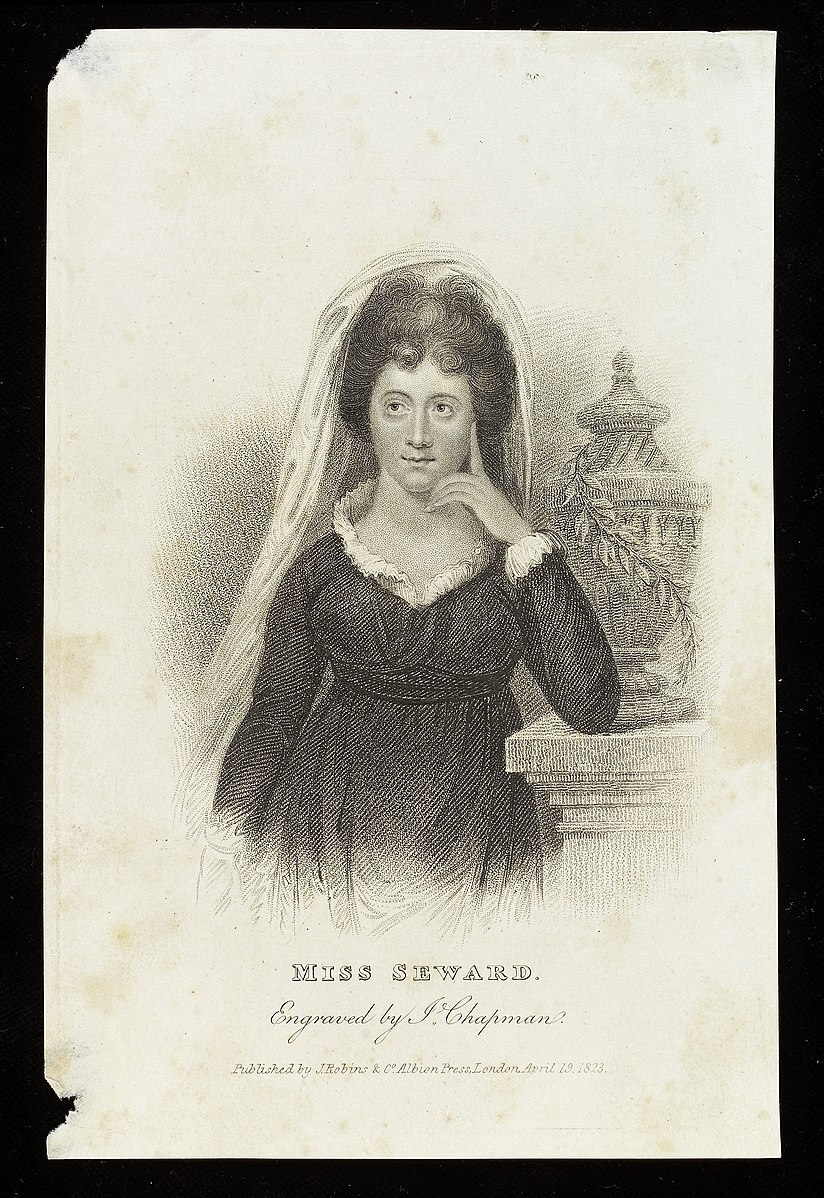Birth
December 12th, 1742, Eyam, Derbyshire, UK
Death
March 25th, 1809, Lichfield, Staffordshire, UK
Anna Seward was an English Romantic poet and novelist. Her most famous works are Monody on Major Andre (1780) and Elegy on Captain Cook (1781). She was one of the most well-known authors of her time, but she was largely forgotten after her death.
Personal Information
Name(s)
Anna Seward, “The Swan of Lichfield,” Nancy (by her family), Julia (by her close friends)
Date and place of birth
December 12th, 1742, Eyam, Derbyshire, UK
Date and place of death
March 25th, 1809, Lichfield, Staffordshire, UK
Family
Mother: Elizabeth Hunter (d.1780), later Seward. Hunter came from a well-known family in Lichfield. Her father was the headmaster of the Lichfield Grammar School (now The King Edward VI School), which Samuel Johnson, David Garrick and Joseph Addison attended. Hunter discouraged her daughter’s literary pursuits.
Father: Thomas Seward (1708-1790) was an Anglican clergyman from Eyam, Derbyshire. He attended St. John’s College, Cambridge, graduating in 1730 (B.A.) and 1734 (M.A.). He acted as chaplain and tutor to the 2nd Duke of Grafton, and later became rector of Eyam and Kingsley. In 1749, he was appointed canon of Lichfield Cathedral, becoming canon residentiary in 1755. He encouraged Seward’s love of poetry from a tender age, as well as her writing, though not her career as an author. He was himself a poet and he published four sermons (1750-1756), an essay titled “The Conformity between Popery and Paganism” (1746), the poem “The Female Right to Literature” (1748), published in an anthology, and was a co-editor of The Works of Beaumont and Fletcher (1750).
Marriage and Family Life
Seward had a biological sister, Sarah Seward (1744-1764), who died of typhus on the eve of her wedding day.
In 1756, when the mother of a young girl named Honora Sneyd (1751-1780) passed away, Sneyd moved in with the Seward family. Though she was several years younger than Seward, Sneyd and Seward grew close. Seward went on to write profusely about Sneyd throughout her life in works such as: “The Visions, an Elegy” (1764), “Honora, an Elegy” (1769), “The Anniversary” (1769), “Ode to Content” (n.d.), “Epistle to Miss Honora Sneyd” (1770), “Elegy at the Sea-side and Addressed to Miss Honora Sneyd,” “Epistle to Miss Honora Sneyd” (1772), “Time Past” (1773), “Lichfield, an Elegy” (1781), “Invocation to the Genius of Slumber” (1787), and “To Remembrance” (n.d.). Sneyd married Richard Lovell Edgeworth in 1773. Sneyd went on to raise her siblings, among them the novelist Maria Edgeworth (1768-1849).
Sneyd had previously been engaged to Major John André, who was hanged as a spy in the American Revolutionary War, and about whom Seward wrote the successful Monody on Major André (1781). She was interested in the Rousseauian principles of education and applied them to her large family. She co-wrote the educational treatise Practical Education, later published by her husband and stepdaughter Maria. She died of consumption in 1780.
Seward never married and she had no children.
Education
Seward, home-schooled by her father and taught domestic arts by her mother, was encouraged in her love for literature by the former. She learned theology, basic mathematics, reading, writing, and piano. She had access to her parents’ books and to Lichfield Cathedral’s library; she was an expert in classic English literature, memorising Milton at an early age. In addition, she benefited from her parents’ habit of hosting figures with intellectual and cultural sensibilities. Later, and together with her friends John Saville and Erasmus Darwin, Seward developed a love for botany that led to her writing poetry with scientific themes that also explore contemporary ideas on female education.
Religion
Anglican
Transformation(s)
The French Revolution and the American Revolutionary War deeply impacted Seward and were a recurrent theme in her poetry. In this sense, she did not modify gendered assumptions but rather joined the chorus of women writers publishing on political matters, with the larger aim to formulate and consolidate the idea of Britishness in a time of socio-political turmoil.
Additionally, Seward was active in a transitional time between two cultural movements, the Enlightenment and Romanticism. An example of this is found in her public debate with James Boswell over the professionalisation and consequent genderization of literary criticism. Seward, a well-respected, experienced, and knowledgeable literary critic, was dismissed by Boswell on account of her gender and age; her position as a woman writer apparently incapacitated her from producing judicious comments on intellectual merit. Finally, recent research has highlighted the intergenerational mentorship Seward pursued in her older age.
Contemporaneous Network(s)
The Lichfield cultural circle Seward frequented included Richard Lovell Edgeworth, Thomas Day, Esther Thrale Piozzi, Frances Brooke, Penelope Weston Pennington, and James Boswell, all of them close friends of Samuel Johnson. Seward was also well acquainted with the members of the Lunar society, and, though excluded from their meetings, she often conversed and shared ideas with them. She also collaborated with the physician Erasmus Darwin; the manufacturer Matthew Boulton; the steam engine inventor James Watt; the potter Josiah Wedgwood; the dissenters and chemists Joseph Priestley and James Keir; the clockmaker John Whitehurst; the diplomat William Small; the botanist William Withering; as well as Edgeworth and Day.
Other members of Seward’s circle were the violinist Wilhelm Cramer and the landscape gardener Humphry Repton. Walter Scott and Robert Southey came to call on Anna Seward in the Bishop’s Palace during the final years of her life. Seward hardly ever visited London and was not part of the Bluestocking Circle. Instead, she chose the polite gentry of Lady Miller’s Bath-Easton assemblies as a trial audience before embarking on her public career. Seward maintained her vast network of friends and acquaintances through her correspondence, which included authors like Helen Maria Williams, Eliza and William Hayley (whom she visited at Eartham), Anna Roger Stokes, Francis Noel Mundy, Henry Cary, T.S. Whalley, Edward Jerningham, and Mary Scott. Seward was also close to the Ladies of Llangollen and cherished the quiet, intellectual, and female-only repose that their home afforded to their visitors.
*See our schemas on Helen Maria Williams and Mary Scott for more information.
less
Significance
Works/Agency
Seward’s major works, all published in her lifetime, are Monody on Major André (1780), Elegy on Captain Cook (1781), which prompted her immediate rise to fame, gaining her recognition both in England and America (Monody was published in Boston, New York, Philadelphia, and Hanover, New Hampshire), the elegiac Poem to the Memory of Lady Miller (1782), in honour of the Bath-Easton hostess; Ode on General Eliott’s Return from Gibraltar (1787); Llangollen Vale, with Other Poems (1796), after the Ladies of Llangollen; Original Sonnets in Various Subjects: and Odes Paraphrased from Horace (1799); the epistolary novel in verse Louisa, a Poetical Novel in Four Epistles (1784); and Memoirs of the Life of Dr. Darwin (1804). She left unfinished a final poem in three books, Telemachus. She also penned early-age journals and sermons, and routinely published poetry and literary criticism in several literary journals, including The Gentleman’s Magazine, the European Magazine, The Monthly Mirror, The Analytical Review and The Edinburgh Review.
Seward was a prolific epistolary writer. Her collected correspondence, Letters of Anna Seward: Written Between the Years 1784 and 1807, were posthumously published by Archibald Constable in 1811. They might have served as an autobiographical record of Seward’s literary criticism and political thought had they not been so heavily censored by their editors. As for her poetry, The Poetical Works of Anna Seward: With Extracts from Her Literary Correspondence was edited by Walter Scott and published in 1810. Seward carefully planned both publications, agreeing on the terms with Constable and Scott beforehand. They were intended to secure Seward’s literary fame and display her literary and intellectual accomplishments and merit. Regrettably, her editors’ alterations rendered Seward’s self-presentation unrecognisable and her project a failure.
Reputation
Seward existed at the centre of a wide network of influential people and was one of the best-known writers of her time. She was a national spokeswoman at a time when the country was widely consolidating British values; her patriotic poems and critical essays promoted her contemporaries and the relevance of English literature. Nevertheless, after her death, she lost critical favour and all but disappeared from the literary landscape.
Although mentions of Seward as a major woman writer of the British Isles are consistent throughout the nineteenth century in both England and the United States, interest in Seward was reawakened in the early twentieth century with E.V. Lucas’ A Swan and her Friends (1907), Martin Stapleton’s Anna Seward and Classic Lichfield (1909), Margaret Ashmun's The Singing Swan (1931) and Hesketh Pearson’s The Swan of Lichfield (1936), which offers a poorly researched overview of Lichfield’s circle, with Seward at its core. The revived interest in the Bluestocking Circle in the 1990s prompted the inclusion of Seward in Gary Kelly’s 1999 series Bluestocking feminism and in anthologies such as Paula Feldman’s British Women Poets of the Romantic Era (1997). In the last twenty years, Seward has received the critical attention she was due. Examples include Paula Backscheider’s seminal study Eighteenth-century Women Poets and Their Poetry (2005) and the work of scholars like Norma Clarke, Gillen D’Arcy Wood, Melissa Bailes, Margaret Dickie, David Wheeler, Claudia Kairoff, John Brewer, and Stuart Curran, who have argued for Seward’s relevance at the critical shift between the Enlightenment and Romanticism. At present there are two monographs—Teresa Barnard’s Anna Seward, A Constructed Life (2009) and Claudia Kairoff’s Anna Seward and the End of the Eighteenth Century (2012)—and two modern compilations of her work, in Lisa Moore’s The Collected Poems of Anna Seward (2016) and Barnard’s Anna Seward’s Journal and Sermons (2017).
Legacy and Influence
In recent years, the city of Lichfield has been working to bring Seward’s name back from obscurity, and proudly boasts of Seward as a celebrated former resident alongside Erasmus Darwin and Samuel Johnson. Both the Samuel Johnson Birthplace Museum and the Erasmus Darwin House Museum include Seward in their guided tours, displays, and talks. A new school, due to open in September 2023, is named the “Anna Seward Primary School”. They recently unveiled their logo, featuring a swan, after the author’s “Swan of Lichfield” nickname.
less
Controversies
Controversy
Seward participated in several literary debates in the pages of well-known periodicals. The Benvolio debates against James Boswell in The Gentleman’s Magazine (1786-1793) present a paper-war between two contending, gender-coded factions of literary criticism; Seward represented amateur, female critics and Boswell stood for male, supposed professional critics. She also participated in the Dryden vs. Pope debates from 1789-91, also known as the Weston Controversy. Here, she criticises Joseph Weston’s claim about the inferiority of modern poetry compared to the classic literary icons. Seward championed those whom she considered examples of poetic excellence. Seward’s voice was also resonant in the pulpit oratory debate with Edward Jerningham over the merits of French Catholic sermons over Anglican sermons (1805).
All of these public debates showcase her literary ability and knowledge. They enlighten our notion of her authorial and critical identity.
less
Clusters & Search Terms
Current Identification(s)
Gender studies, age studies, eighteenth-century studies, Romanticism, literary history
Clusters
Samuel Johnson’s circle: James Boswell, Frances Brooke, Esther Thrale Piozzi, Penelope Weston Pennington.
Lady Miller’s Bath-Easton assemblies: provincial, polite society led by Anna Miller. Seward shared this space with friends such as Eliza and William Hayley, T.S. Whalley, Edward Jerningham, and Anna Roger Stokes.
Lunar society: This coterie was formed by poet and physician Erasmus Darwin, the manufacturer Matthew Boulton, the steam engine inventor James Watt, the potter Josiah Wedgwood, the dissenters and chemists Joseph Priestley and James Keir, the clockmaker John Whitehurst, the diplomat William Small, the botanist William Withering, the writer Richard Lovell Edgeworth, and the author Thomas Day. While Seward was not part of the Lunar Society, she was close to most of these men.
Intergenerational mentoring: In her old age, Seward was favoured for her literary acumen and experience in the book market by figures such as Walter Scott, Robert Southey, Thomas Lister, and Henry Cary.
Search Terms
English poet, British poet, Lichfield, woman writer, James Boswell, Samuel Johnson, Major André, Romanticism
References in existing schemas
Helen Maria Williams, Mary Scott, Charlotte Smith.
less
Bibliography
Primary (selected)
Seward, Anna. Poem to the Memory of Lady Miller. By Miss Seward. London: G. Robinson, 1782.
---. Louisa: A Poetical Novel, in Four Epistles. Lichfield: J. Jackson and G. Robinson, 1784.
---. Ode on General Eliott’s Return from Gibraltar. London: T. Cadell, 1787.
---. Llangollen Vale; and Other Poems. London: G. Sael, 1796.
---. Original Sonnets on Various Subjects; and Odes Paraphrased from Horace. London: G. Sael, 1799.
---. Poetical Works of Anna Seward. With Extracts from her Literary Correspondence. Walter Scott (ed.), Edinburgh: J. Ballantine and Co, 1810. 3 vols.
---. Letters of Anna Seward, Written between the Years 1784 and 1807. Archibald Constable (ed.), Edinburgh: A. Constable, 1811. 6 vols.
Barnard, Teresa. Anna Seward’s Journals and Sermons. Newcastle upon Tyne: Cambridge Scholars Publishing, 2017.
Foster, Gretchen M. Pope Versus Dryden: A Controversy in Letters to the Gentleman’s Magazine. Victoria: University of Victoria, 1989.
Archival Resources (selected):
Seward’s manuscript corpus is scattered over English, American, and Canadian archives, and part of it is suspected to be privately owned. Part of her primary sources have been digitised and are available on Eighteenth Century Collections Online database, Google Books, Archive.org, and Hathi Trust Digital Library. Some of her letters are held at the Samuel Johnson Birthplace Museum, Lichfield (Staffordshire), the Staffordshire Record Office and the William Salt Library, Stafford (Staffordshire), the Weston Library, Oxford, the John Rylands Library (Manchester), and the British Library. Part of the manuscript she bequeathed to Walter Scott for publication can be found in the National Library of Scotland, Edinburgh.
Web Resources (selected):
Aston, Nigel. “Horne, George (1730–1792), Bishop of Norwich”. Oxford Dictionary of National Biography, oxforddnb.com/view/10.1093/ref:odnb/9780198614128.001.0001/odnb-97801986141 28-e-13789/, 23 Sep 2004. Oxford University Press. Accessed 21 Sept. 2018.




Comment
Your message was sent successfully